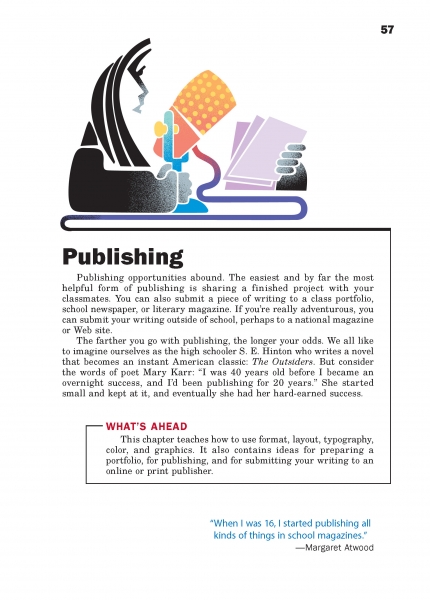Page 057 from

Start-Up Activity
Use the following activity as a publishing warm up:
-
Ask each person in the class to write a one-sentence message in the middle of a piece of paper. Students can write about any topic and purpose that is school appropriate, but they should know the message may be shared with the class.
-
After students have finished writing, tell them they must fold their messages into paper airplanes. Then they need to take their airplanes with them to line up along the back wall of the class. Designate one end of the line (preferably the end farthest from the open door of the class) as the "start."
-
The person at the start must try to fly the airplane out the doorway. Leave the plane where it lands as the next person steps to the start and launches the next message.
-
Once all students have sent their messages, select the one that went farthest (perhaps out the door), and read it aloud to the class.
Point out that publishing is just like this airplane game: writing and packaging a message and then launching it to see how far it goes. This chapter will help students discover strategies for packaging and launching their works.
Think About It
“These airplanes we have today are no more than a perfection of a child's toy made of paper.”
—Henri Coanda

Start-Up Activity
Use the following activity as a publishing warm up:
-
Ask each person in the class to write a one-sentence message in the middle of a piece of paper. Students can write about any topic and purpose that is school appropriate, but they should know the message may be shared with the class.
-
After students have finished writing, tell them they must fold their messages into paper airplanes. Then they need to take their airplanes with them to line up along the back wall of the class. Designate one end of the line (preferably the end farthest from the open door of the class) as the "start."
-
The person at the start must try to fly the airplane out the doorway. Leave the plane where it lands as the next person steps to the start and launches the next message.
-
Once all students have sent their messages, select the one that went farthest (perhaps out the door), and read it aloud to the class.
Point out that publishing is just like this airplane game: writing and packaging a message and then launching it to see how far it goes. This chapter will help students discover strategies for packaging and launching their works.
Think About It
“These airplanes we have today are no more than a perfection of a child's toy made of paper.”
—Henri Coanda



